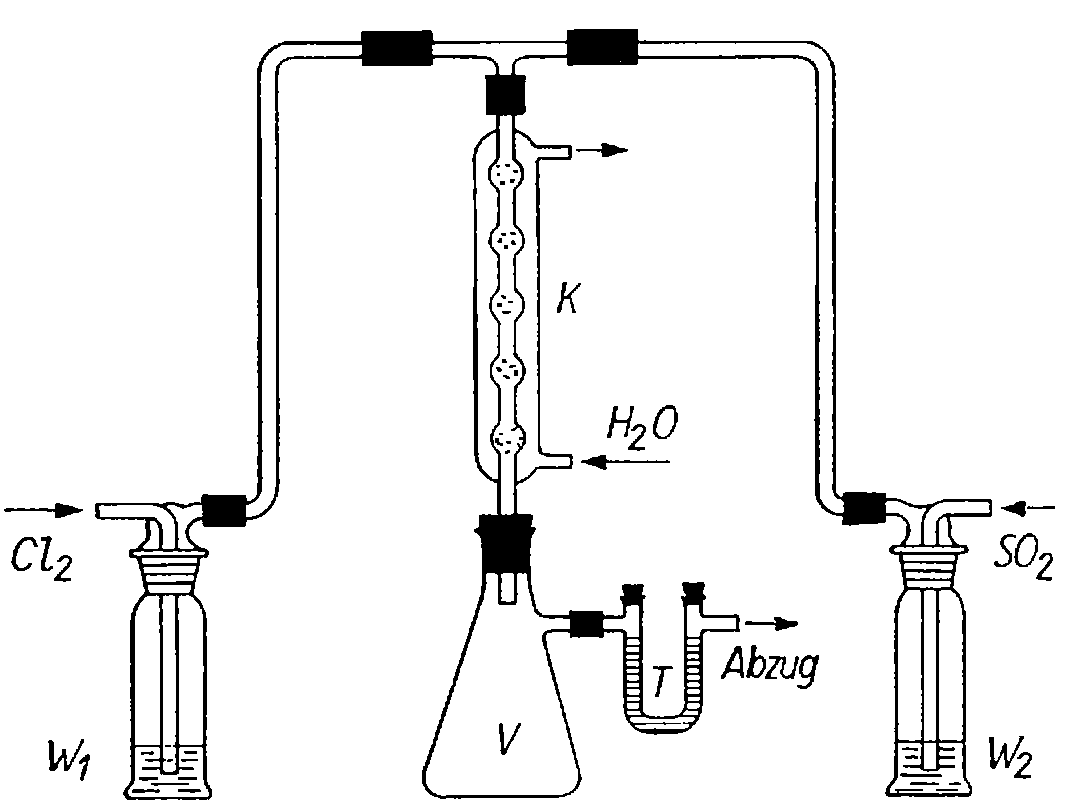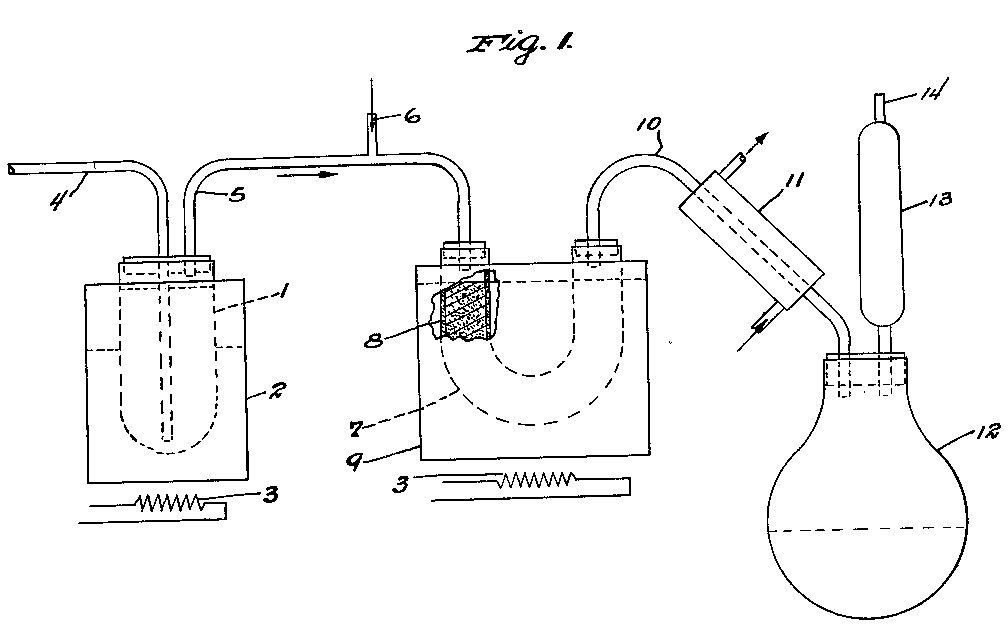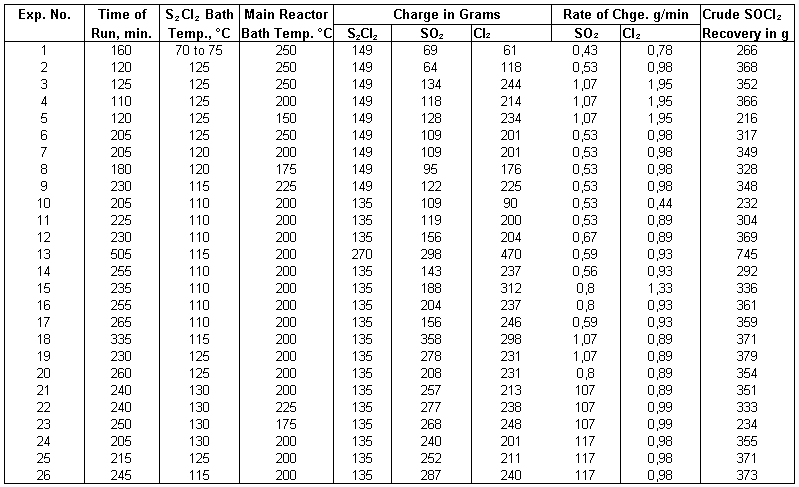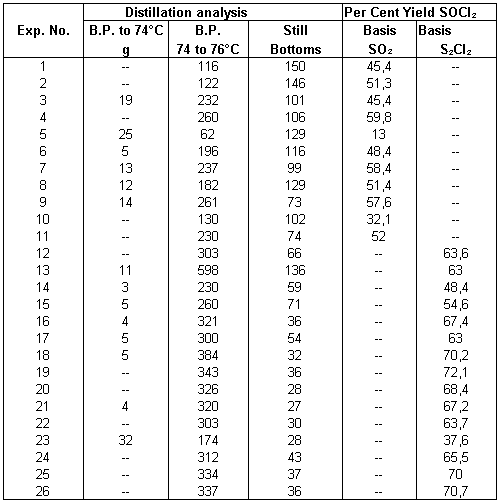(Hive Addict)
06-20-04 04:41
No 514352
(Rated as: excellent)
Mountain_Girl wasn't able to produce any SOCl2 by the method of Patent US1861900 - Post 257083 (Mountain_Girl: "Cl2, S2Cl2, SOCl2 & acid chlorides", Novel Discourse). This was the only attempt reported to the hive that I know of. I think the impression that making thionylchloride is impossible should not prevail. If Liebig's contemporaries could do it, it can be done today.
 Ber. 1883;483
Ber. 1883;483thionylchloride and pyrosulfurylchloride from sulfur monochloride, sulfur trioxide and chlorine
22g S2Cl2, cooled to -19°C with an ice/salt mix, were completely saturated with Cl2 and 50g dry SO3 distilled thither from 100g oleum, while a Cl2 stream was permanently conducted thru the liquid. Thereby first a crystalline mass formed that wasn't stable and reliquified when the ice/salt mix was replaced with water of 0°C. SO2 only emerged at the end of the operation and not in considerable amounts. CO2 was conducted thru the liquid, that was heated a little in the end, to remove any possibly absorbed Cl2. The product was fractionally distilled. 56g colorless S2O5Cl2 and 22g still slightly yellow SOCl2 were thus obtained.
related ref: Liebigs Ann.Chem. : 170.1873;1-42
 Z.Chem. : 23,12.1983;436
Z.Chem. : 23,12.1983;436This one is promising, but cannot be more than a weird hint:
thionylchloride from sulfur monochloride and aluminium oxide
Chlorination of gamma-Al2O3 with S2Cl2 and Cl2 in a ratio of S2Cl2:Cl2=1:3 gives AlCl3 and SOCl2 above 100°C.
2 Al2O3 + 3 S2Cl2 + 9 Cl2 __> 4 AlCl3 + 6 SOCl2
Reaction was conducted in pipe bombs, trxn wasn't specified in the article more precisley than between 3-80h, the Beilstein abstract however says 48h.
The references given in the article didn't deal with anything concerning the reaction in question.
Patent DE139455
thionylchloride from sulfur trioxide and sulfur dichloride
1000kg sulfur trioxide are slowly added to 1000kg S2Cl2, that are contained in a vessel equipped with reflux condensor and stirrer. Temperature is held between 75 and 80°C. Chlorine is constantly introduced to chlorinate the S, that forms as reaction product, back to sulfur monochloride to prevent reaction with SO3. Reaction products are rectified.
Patent DE275387
thionylchloride from SCl2 catalysed by SbCl3
In an iron vessel fittet with a stirrer to 1000 parts SCl2 and 10 parts SbCl3 as catalyst, at 10 - 15°C the theoretical amount of SO3 is distilled thereto. Purificatin by fractional distillation, high yield of thionylchloride.
Also of interest here: Patent US2420623 and Feher, F.; Brauer, G., Handbuch der praeparativen anorganischen Chemie, Stuttgart 1954, page 294
Patent US236057
thionylchloride from oleum, sulfur monochloride/sulfur dichloride and chlorine
Heretofore thionyl chloride has been produced by reaction of sulphuric acid or sulphur trioxide with sulphur monochloride and chlorine or with sulphur dichlorlde. The reaction of sulphuric acid with these chlorides of sulphur is as follows:
4 H2SO4 + 3 S2Cl2 + 5 Cl2 __> 4 SOCl2 + 6 SO2 + 8 HCl (1)
4 H2SO4 + 6 SCl2 + 2 Cl2 __> 4 SOCl2 + 6 SO2 + 8 HCl (2)
The reaction of sulphur trioxide with these chlorides of sulphur is as follows:
2 SO3 + S2Cl2 + Cl2 __> 2 SOCl2 + 2 SO2 (3)
2 SO3 + 2 SCl2 __> 2 SOCl2 + 2 SO2 (4)
Reactions {1) and (2) are generally unsatisfactory because of the fact that for every molecule of SOCl2 two molecules of HCl are produced.
The HCl comes off mixed with SO2 from which it must be separated, and there is not always a sufficient demand for this byproduct. Sulphur trioxide as such is expensive and Reactions (3) and (4) are commonly carried out by means of SO3, evolved from oleum. As the heat of reaction is considerable and SO3, boils at about 46° C., it is reacted in gas phase. In the case of Reaction (3) chlorine is passed in at the same time to avoid production of sulfuryl chloride and pyrosulfuryl chloride.
I have now discovered that instead of-evolving SO3 from oleum, for use in the above reactions, the oleum itself may be advantageously used directly in the reactions. Assuming oleum containing 70 per cent SO3, the reactions are as follows:
6 (H2SO4 + 2.83 SO3) + 13 S2Cl2 + 16 Cl2 __> 22.98 SOCl2 + 25.98 SO2 + 12 HCl (5)
6(H2SO4+2.83 SO3) + 26 SCl2 + 3Cl2 __> 22.98 SOCl2 + 25.98 SO2 + 12 HCl (6)
It is to be understood, that Reactions (5) and (6) may be combined by using a mixture of sulphur monochloride and dichloride.
It should be noted that in these reactions the SO3 is reacted in liquid phase. This results in more intimate contact and a consequent reduction of about one half in the time of reaction, namely from 100 hours to from 45 to 50 hours. It also results in a better yield with respect to the SO3. Moreover it will be observed by comparison of Reactions (1) and (2) with Reactions (5) and (6) that the quantity of byproduct HCl is decreased from a ratio of two molecules of HCl to one of SO2 to a ratio of one molecule of HCl to nearly two of SOCl2; or, in other words, the molecular proportion of HCl produced for a given quantity of SOCl2 is decreased to a little more than one quarter of that produced in the reaction with sulphuric acid alone, which is the only reaction of the prior art that is practicable for carrying out in liquid phase. Besides the saving in time, improved yield and reduction in byproduct HCl. a further practical advantage as compared with the process in which SO3 is evolved from the oleum is that no H2SO4 is left over to be shipped back to the manufacturer of the oleum.
Reactions (5) and (6) are preferably carried out in a glasslined, jacketed, iron reactor, equipped with an agitator, manometer, thermometer well exits for SO2 and HCl and a reflux condenser. There must also be a chlorine inlet tube, which should extend to near the bottom of the reactor. The oleum should have as high a content of SO3 as practicable and should preferably be liquid. In order to minimize production of higher oxides of SCl2 e. g., sulfuryl and pyrosulfuryl chloride, and afford better control of the reaction, which is otherwise quite violent, the oleum is preferably added gradually to a body of the' chlorides of sulphur, so that the latter may be in large excess until near the finish of the reaction. The sulphur monochloride or dichloride is therefore first charged into the reactor. If desired, antimony trichlorlde may be added to serve as catalyst. With the agitator working and cooling water flowing in the reactor jackets, the oleum is added at such a rate that the temperature is kept below 45°C and preferably at substantially 25°C. The admission of chlorine may be started at the same time or later, depending upon whether sulphur monochloride or dichloride is the other reagent. At the finish it is desirable that there should be a slight excess of both oleum and chlorine in the mixture over the theoretical quantity.
After the optimum quantities of oleum and chlorine have been added the charge is heated by passing steam through the reactor jacket and refluxed until the refluxing temperature has became stabilized at substantially 75° C., which is the boiling point of thionyl chloride. The product is then distilled away from residual reagents and high boiling oxides and other impurities and further treated by any of the known ways to purify it.
Z.Anorg.Allg.Chem. : 233.1937;385-400 and Z.Anorg.Allg.Chem. : 211.1933;150-160 S2O + 2 Cl2 __> SOCl2 + SCl2
S2O
Z.Anorg.Allg.Chem. : 319.1963;337-349
Z.Naturforsch. b : 19.1964;535-536
Z.Naturforsch. : 20b.1965;809
Can.J.Chem. : 43.1965;2357-2362
--psyloxy--
(Hive Addict)
06-21-04 00:35
No 514472
 Jander, Blasius 1983
Jander, Blasius 1983sulfurylchloride
The globes of cooler K are alternately filled with a layer of loose fiberglass and a layer of granulated charcoal. After the water in cooler k is running, equally strong streams (3-5 bubbles/s) of dry SO2 and Cl2 (washbottles W1 and W2 filled w/conc. H2SO4) are allowed to enter the cooler. The charcoal saturates with Cl2 and SO2 or SO2Cl2 respectively first. After ~10-30min SO2Cl2 drops into the cooled receiving flask V. The excess gas mix is directly led to the fume hood thru a CaCl2 drying tube T. At the right dosage 150g SO2Cl2 are formed per hour.
Cl2 is removed by blowing N2 thru the ice cooled receiving flask V. Final purification is done via column distillation. The fraction boiling between 68-70°C is collected.
Reaction runs smoothly and gives nearly quantitative yield.

--psyloxy--
(Hive Addict)
06-21-04 00:40
No 514474
Patent DE644222
To 1 mol finely milled dry NaCl, that is situated in a vessel that is airtight or only accessible to thoroughly dried air, 1 mol 100% SO3 or the equivalent amount of 96% SO3 (96% oleum) are carefully and slowly added with constant stirring so that no sulfur trioxide is lost. After complete addition the mix is stirred for 2h without heating or cooling. The reaction mix is then cooled to 30°C. The NaSO3Cl is 98-99% pure and formed quantitatively.
Patent CH156426
The trick here is to use oleum and NaCl in such proportions that HSO3Cl is the only liquid reaction product so that it can be easily distilled at the end.
H2SO4 + 2 SO3 + NaCl --> NaHS2O7 + SO3HCl
H2SO4 + 3 SO3 + 2 NaCl --> Na2S2O7 + 2 SO3HCl
120 parts dry finely milled NaCl are carefully stirred into 340 parts oleum of 70% SO3 content, so that neither HCl nor SO3 escape from the reflux cooler. Due to the reaction the temperature rises to ~150°C (bp of chlorosulfonic acid). After the bringing in this temperature is kept for some time. The HSO3Cl is subsequently distilled from the mushy mass.
Patent DE543758
Cleaning HSO3Cl through distillation is impossible because of side reactions taking place.
at normal pressure, ~150°C: distillation product will be contaminated with ~5% SO2Cl2 and ~5% S2O5Cl2.
at 15-20 mmHg : HSO3Cl __> SO3 + HCl^ ; product of distillation contains ~10% free sulphur trioxide
Remedy : SO3 + HCl __> HSO3Cl ; 70°C < T < 100°C
I hate it when they don't give examples in patents, if anyone is intrested in this, I could give a more detailed translation.
using ball mills : Patent US2219103 Patent GB22209 Patent DE680565
gas phase reaction : Patent US2218729
HCl speeds it up Patent US2276041
industrial style Patent US2377642 Patent US2415358
 Ber. 1883;485
Ber. 1883;485chlorosulfonic acid from pyrosulfurylchloride and water
S2O5Cl2 + H2O __> HSO3Cl
40g pyrosulfurylchloride (180 mmol) were warmed with 3g water (166 mmol) and the product distilled, the main fraction came over at 154 - 158°C (B=723mm).
Product is contaminated with a little starting material, boiling points are too close.
J.Chem.Soc. : 10.1858;97-102; chlorosulphonic acid from sulfuric acid and chlorine
--psyloxy--
(Hive Addict)
06-21-04 00:47
No 514475
preparation of S2Cl2
Post 208025 (Antoncho: "Preparation of S2Cl2", Novel Discourse)
Post 208077 (catastrophe: "Re: Preparation of S2Cl2", Novel Discourse)
Post 511629 (psyloxy: "easy, high-yield S2Cl2", Chemistry Discourse)
preparation of SCl2
Patent DE49628 2 NaCl + 2 S __> SCl2 + Na2S
J.Chem.Soc. : 1934;1283 S2Cl2 + Cl2 __> 2 SCl2
Z.Phys.Ch. : 54.1906;55-97 S2Cl2 + Cl2 __> 2 SCl2 w/SnCl4 as catalyst
SCl4: mp: -30°C (decomposition)
--psyloxy--
(Hive Addict)
06-22-04 22:14
No 514816
 Trans. Faraday Soc., 43.1947;667-6723
Trans. Faraday Soc., 43.1947;667-6723Summary
The oxidation of SCl2 by atmospheric oxygen has been investigated using activated charcoal as the catalyst. The reaction has been discussed in terms of two reactions. Firstly, the irreversible oxidation of SCl2 to SO2Cl2 :
SCl2 + O2 __> SO2Cl2
and secondly, the reversible reaction between the SCl2 and the SO2Cl2 to form SOCl2 :
SCl2 + SO2Cl2 <__> SOCl2
This oxidation has been investigated at the temperatures 193°C, 138°C and 320°C, and the equilibrium constant of the reversible equilibrium reaction has been determined for each temperature. From the temperature dependence of this equilibrium constant it is found that the reaction is exothermic to the extent of 18 kcal.
(Yield of SOCl2 at 193°C : ~73%)
--psyloxy--
(Hive Addict)
06-22-04 22:39
No 514821
 Feher, F.; Brauer, G., Handbuch der praeparativen anorganischen Chemie, Stuttgart 1954, page 294
Feher, F.; Brauer, G., Handbuch der praeparativen anorganischen Chemie, Stuttgart 1954, page 294thionylchloride - SOCl2 see article for picure of used apparatus
SCl2 + SO3 __> SOCl2 + SO2
Flask A is filled with 65% oleum, flask B with 100g SCl2. A is slowly heated in an H2SO4 bath, while B is cooled with ice water. The sulfur trioxide is slowly distilled into the sulfur dichloride, caution: SO2 evolves; at the beginning the flask's (A) contents tend to nearly solidify, at the end of the addition it shall be liquid again - a water bath can be applied. Then flask A is removed, the connection C is closed and the reaction mixture is slowly distilled with a column under exclusion of humidity. The middle-fraction is refined again by repeated distillation over sulfur using a good column, until a totally colorless product is gained, that boils between 76-77°C. Yield: ~80%
Shortly above the bp SOCl2 dissociates noticeably into S2Cl2, SO2 and Cl2
--psyloxy--
(Hive Addict)
06-23-04 23:29
No 515042
Patent DE939571
Example
135g S2Cl2,80g SO3 (both as vapor) and ~150g Cl2 per hour are conducted thru a tube of 350mL that is filled with grained charcoal activated with K2S and held at 180°C. From the connected cooler 325g of a liquid that is 86% SOCl2 condense per hour. Yield: 78,5%
Patent DE842041
Example
An equimolar mixture of SCl2 and SO2Cl2 is vaporized and, in slow stream, is led thru a tube that contains activated charcoal at 190°C. In the connected cooler a liquid condenses that contains 15% SCl2, 9% SO2 and chlorine besides the thionylchloride. The dissolved gasses escape on heating and are reused.
sulfurylchloride can be replaced by an equimolar mixture of SO2 and Cl2, SO2Cl2 dissociates above ~100°C anyway.
For a comprehensive review in English see: Patent US2431823, in German: Patent DE803411, also CA 1963;5285.
thionylchloride from SO2 with CO and Cl2
Patent US12471946
Patent DE284935
--psyloxy--
(Hive Bee)
06-26-04 15:12
No 515539
Nice work Psyloxy!
"Mountain_Girl wasn't able to produce any SOCl2 by the method"
Still not sure why it didn't work but I did only try it once which experience tells me is not enough under typical clandestine conditions. Also, I recall that one thing I definitely did wrong is was the synth of the ferric chloride catalyst. I dissolved iron nails in aqueous HCl which produces ferrous not ferric chloride. I think I have described the correct synth somewhere around here (using using chlorine gas as usual methinks).
So I believe the method for SOCl2 may still be feasible with some more trials. Unfortunately it is far from effortless.
Mountain Boy
(Hive Addict)
06-27-04 03:31
No 515659
(Rated as: excellent)
Mountain_G/B: Your appreciation is appreciated
Patent US2431823 Fantastic Method ! Charcoal catalysed rxn. of SO2, Cl2 and S2Cl2, including purification

A stoppered flask 1 is suspended in a wax bath 2 heated by a flame or other source of heat 3. An inlet tube 4 projects through the stopper into the flask 1. Outlet 5 projects thrugh the stopper into the flask to a point well above the liquid level therein. Outlet 5 after junction with tube 6 leads into one end of a conventional stoppered U-tube reactor 7 nearly filled with a body of finely divided activated charcoal 8 and suspended in a wax bath 9, heated as at 3. From the other ends of U-tube 7, a conduit 10 leads through a water jacketed condenser 11 into a stoppered receiving flask 12. A conventional column 13, preferably packed with Pyrex class spirals communicates at its base with flask 12 and serves to trap uncondensed vapors proceeding toward gas take off 14.
In a typical operation, flask 1 is nearly filled with a body of sulfur monochloride and the wax in bath 2 is heated to a temperature substantially in excess of 59°C, but below the boiling point of sulfur dichloride, say 120°C. Chlorine gas is introduced through inlet 4 at such a rate that sulfur dichloride is continuously formed and vaporized in the flask 1. Vapors of SCl2 together with any excess Cl2 and some vapors of sulfur monochloride emanating from flask 1 are removed through outlet 5. Sulfur dioxide and additional chlorine are introduced into the stream via tube 6 and mixed vapors proceed to the inlet side of U-tube 7. The wax bath 9 is maintained at a temperature of about 200°C. Afterpassing through hot charcoalbed 8, the reaction products pass to receiver 12. Chlorides of sulfur and thionyl chloride remain in the flask, unreacted chlorine SO[sub/]2[/sub] being separated and removed as off gases through outlet 14.
In the following tables there are presented the results of a series of experimental runs in which the apparatus employed correspond with that in Fig.1. The tables nicely illustrate how the variation of certain conditions in the process modifies the results. In these experiments approximately one-third of the chlorine used was introduced through the inlet 4 and the balance, together with the SO2 through tube 6.
Table I

In analysis of the crude liquid reaction product recovered in receiver 12, a packed column with a distilling haed was employed to control reflux rates.
Table II

The fraction boiling up from 74°C is principally SCl2; that boiling from 74° to 76°C is principally thionyl chloride, while the distillation residue is sulfur and sulfur monochloride. Sulfur was added to the crude liquid before distillation. In the absence of iron the sulfur was dissolved very slowly and separation of the thionyl chloride fraction was difficult. Even where no low boiling fraction was obtained the thionyl chloride fraction was hihgly colored. In certain of the experiments catalytic amounts of iron were added along with sulfur before distillation of the crude thionyl chloride in accordance with the Trager process described above. In such instances, typified in Experiments Nos. 24, 25 and 26, the dichloride was almost immediately converted to monochloride with evolution of heat. The SOCl2 recovered on distillation was much lighter color than the fractions obtained in other analyses.
Analyzing the data presented in the tables, it is evident that when the catalyst bed is maintained at a temperature below 175°C or above 225°C the yield is poor. Best yields were obtained at 200°C. As far as determinable from the available data contact time has little or no effect on yields. While the concentration of the reactants can be varied over wide limits without appreciable effect on yields, the data show that a deficiancy in chlorine is dfinitely undesireable. An excess over theoretical amounts of about 100 per cent for SO2 and 0 to 10 per cent for Cl2 appear to be most desirable.
--psyloxy--
(Hive Addict)
06-28-04 17:37
No 516011
 Feher, F.; Brauer, G., Handbuch der praeparativen anorganischen Chemie, Stuttgart 1954, page 297
Feher, F.; Brauer, G., Handbuch der praeparativen anorganischen Chemie, Stuttgart 1954, page 297A stoppered round bottom flask (thru the stopper go: gas inlet to bottom of flask, thermometer, distillation tube with cooling jacket, ending with a CaCl2 drying-tube) is filled with oleum (SO3 content as high as possible) until half full. At the beginning of the experiment the flask is held at such an angle, that the cooler points upwards so all volatile products condense and are returned to the flask. A thoroughly dried stream of HCl is then slowly led thru the oleum at room temperature until no more absorption takes place. The cooler is then brought back to normal position and the flask's contents are distilled with the HCl stream still on and exclution of moisture. The fraction between 145 - 160°C is collected and again fractionated, this time everything coming over at 151-152°C is collected. At the distillation stage organic substances like rubber, cork and dust must not be present, otherwise the distillate will not be colorless.
Yield, based on SO3 in the oleum is nearly quantitative.
--psyloxy--
(Hive Addict)
06-30-04 21:15
No 516591
From Patent US3592593 :
Suitable active products which can be used in accordance with the present invention are the sulfides such as FeS, Fe2S3 and the like, the oxides such as Fe2O3, Fe3O4, FeO, finely divided iron powder, the inorganic iron salts such as the chlorides, sulfates, phosphates, nitrates and the like.
Preferably the active iron products are used in finely divided form in an amount of between 0.01 to 10, preferably of about 0.02 to 1 gram calculated as elementary iron per 100 grams of sulfur. For obtaining a highly active material the finely divided active iron products are suspended as homogeneously as possible in molten sulfur ....
In Patent EP42530 is stated, that the AlCl3 to be used in their process doesn't have to be dry !
AlCl3 is advertised as an even better SOCl2 cleanup catalyst because it catalyses the breakdown of sulfuryl chloride, which apparently is not present in the product of the procedure in Patent US2431823.
Wiss. Z. Martin-Luther-Univ. Halle-Wittenberg, math.-naturwiss. R. 6.1957;815 says:
Fe + S2Cl2 __138,6°C__> mainly FeCl2 after 7 h, ~3% FeCl3 after 7 h at 400°C.
Fe2O3 gives a mixture of FeCl2, FeCl3 and FeS (proportions not stated in the article) after 10h at 138,6°C but FeCl3 exclusively after 8 h at 350°C.
So everybody quickly forget about my previous statement!
However there's a an interesting sidenote:
1g Hg and 5 mL of S2Cl2 give HgCl2 exclusively (no Hg2Cl2) in quantitative yield after 12 h at room temp. with stirring or after 90 min. at 138,6°C.
Sn reacts violently with S2Cl2 when the mixture is shortly heated to give SnCl4.
--psyloxy--